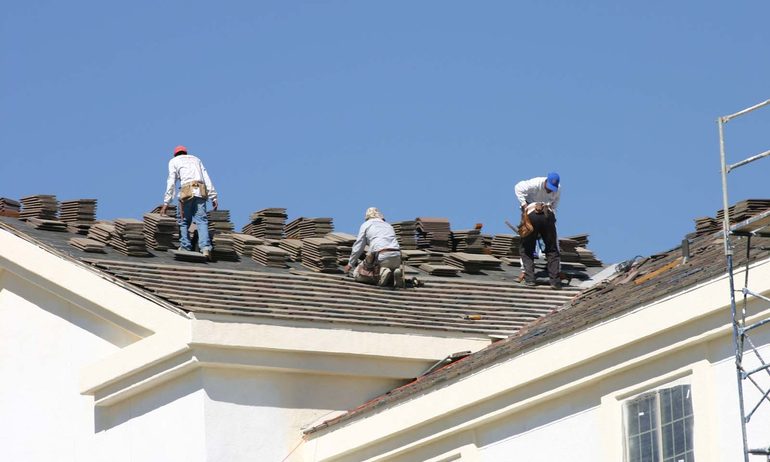Roof Replacement Cost in 2025
Roof replacement costs vary widely; what you pay depends on factors such as materials, roof size, location and contractor.

Some or all of the mortgage lenders featured on our site are advertising partners of NerdWallet, but this does not influence our evaluations, lender star ratings or the order in which lenders are listed on the page. Our opinions are our own. Here is a list of our partners.
Materials: $1 to $30 per square foot
Labor: $40 to $90 per hour
Total: About $4 to $11 per square foot
Materials: $1 to $30 per square foot
Labor: $40 to $90 per hour
Total: About $4 to $11 per square foot
A roof replacement costs $9,500 on average but can range from about $5,800 to $46,000, according to home services website Angi. The actual cost of installing a new roof depends on your location, roof size and dimensions and which roofing company you hire.
Materials also play a key role, with premium options such as slate, clay or copper being on the high end of the range. For most homeowners, labor expenses account for more than half of a roof’s total replacement cost, with the remainder covering materials.
HELOC & Home Equity Loans from our partners

on FourLeaf Federal Credit Union
670
$1,000,000
on FourLeaf Federal Credit Union

on Achieve
Achieve
5.0
NerdWallet rating
5.0
NerdWallet rating600
$300,000
on Achieve
How much does it cost to replace a roof?
Understanding how a new roof is priced can prepare you before reaching out to roofers for estimates — and may highlight line items where you have the flexibility to reduce costs.
Roof size — $4 to $11 per square foot
You can typically expect to spend from $4,000 to $11,000 per thousand square feet using typical materials. A professional estimate will list the size of your roof, which can differ from the square footage of living space inside the home.
Here are estimates of the average cost to replace a roof by size.
Roof Size (Square Feet) | Estimated Price |
|---|---|
1,000 | $4,000 to $11,000. |
1,500 | $6,000 to $16,500. |
2,000 | $8,000 to $22,000. |
2,500 | $10,000 to $27,500. |
3,000 | $12,000 to $33,000. |
Source: Based on Angi cost per square foot. | |
Materials — $1 to $30 per square foot
Asphalt shingles are the most common type of roofing material, but other popular choices include clay, concrete, metal, wood, slate and synthetic alternatives. Each option is priced differently, and some will last longer than others.
Material | Cost (per square foot) | Lifespan (years) |
|---|---|---|
Asphalt | $1 to $1.20. | 10 to 20. |
Clay tiles | $10 to $20 | 50 to 100. |
Concrete | $10 to $20. | 50 to 100. |
Metal shingles or shakes | $6 to $16. | 50 to 75. |
Wood shingles or shakes | $6 to $15. | 30 to 50. |
Slate | $10 to $30. | 125 to 200. |
Synthetic | $5 to $12. | 25 to 50. |
Source: Angi. | ||
» MORE: How much do solar panels cost?
Labor — $40 to $90 per hour
The bulk of a roofing project estimate usually can be attributed to labor costs. According to Angi, professional roofers generally charge around $40 to $90 per hour per worker. The cost will differ based on your location and the specifics of the job.
Simpler roofs will usually be less expensive, while more complex projects (such as when the home has chimneys or skylights) can be more costly.
If your project is not urgent, you may be able to save money by scheduling work outside your region’s high season.
Roof angle or pitch — additional $1,000 to $3,000
In addition to the size of the roof, the height and angle of the roof play a role in total costs. Tall roofs at a steep angle (called the pitch) have more square footage and require more labor, which is likely to increase expenses.
A typical roof is angled four (4:12) to nine (9:12) inches per foot. A roof that is sloped at a 45-degree angle would have a pitch of 12:12.
Steeper angles make the project more difficult and dangerous, so a steeper pitch will often come with a bigger price tag.
Additional cost considerations
While the bulk of the cost of replacement comes from the roof size, materials and the overall complexity of the project, there are additional factors to keep in mind that can affect your estimate.
Location. Roof replacements can cost more in areas with a higher cost of living or where extreme weather conditions are common. Also, if a permit is required in your area, you should anticipate spending up to $500.
Removal and disposal of the old roof. If the original roof has to be torn up and disposed of before the new one can be put down, the roofer will add this to their labor costs.
Any necessary repairs. If the roofer has to make structural repairs in addition to putting down the new roof, this will inflate labor costs.
Roof warranty. Most new roofs come with a limited warranty at no cost, but they may not last the lifetime of the roof. You may have the option to buy an extended warranty or contractor warranty, which can cost from $500 to $5,000, depending on the roof size, materials and warranty length. Before purchasing an extended warranty, be sure to ask what the warranty does and does not cover, and weigh the benefits of this optional expense.
How to choose the best roof financing option for you
Your contractor may offer some financing options (either through a partner or a payment plan), but there are other — and maybe better — financing options available. The best financing option for you depends on several factors:
How much money you need.
When you need it.
How long you need to pay the money back.
» COMPARE: Best roof financing options
Home equity loan or HELOC
If you have a large and expensive roofing project, it’s likely that you will need more time to pay it back. In that case, a home equity loan or HELOC may be your best bet. The downside is that it will take more time to apply and get approval, since your home is collateral and an appraisal may be required.
Personal loan
A personal loan could be used for a small roof repair as well as a larger roofing project. This option makes sense if you don’t have much equity in your home or don’t want to use your home as collateral. In that case, a lender may have stricter credit requirements, since there is no collateral to secure the loan. Loan approval and closing should be faster than for a home equity loan or HELOC.
Credit card
A credit card probably isn’t your best option if you need to pay for an expensive roof replacement, because it’s likely to have a higher interest rate than other options. But a credit card could work for a lower-cost repair. It could also make sense if you want to take advantage of a 0% APR promotional period or earn rewards, and then pay the balance off quickly.
If your roofing contractor offers its own financing, you may be tempted to just go with that. But comparing the contractor’s financing—interest rates, terms and fees—with other options and choosing the best can save you money, especially when your roof replacement comes with a big price tag.














